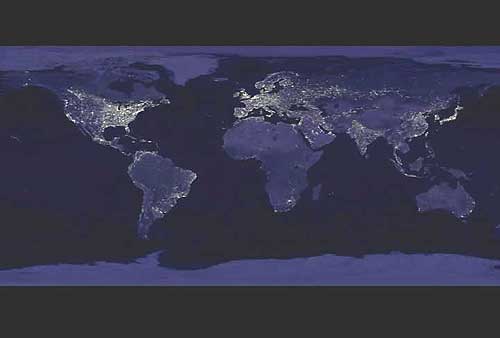 As so often happens, I’ve been challenged by readers. The other day, I posted a short entry, describing a slide that Rem Jackson used in his keynote address at the Georgia Educational Technology Conference. He showed a collage of satellite photographs of the planet earth at night, including city lights. Jackson asked if we thought that the planet had looked like this a million, thousand, hundred, or perhaps even 20 years ago. The point is that lighting up the dark side of the planet has just happened, and it happened to us.
As so often happens, I’ve been challenged by readers. The other day, I posted a short entry, describing a slide that Rem Jackson used in his keynote address at the Georgia Educational Technology Conference. He showed a collage of satellite photographs of the planet earth at night, including city lights. Jackson asked if we thought that the planet had looked like this a million, thousand, hundred, or perhaps even 20 years ago. The point is that lighting up the dark side of the planet has just happened, and it happened to us.
Marco Polo, commented on this posting, feeling picky. Here’s his comment.
it’s happened to us? No, we did it.
And why, or in what way is that powerful, exactly? Is it the lighted parts? Or the dark parts, that attract your attention? Which parts are the powerful parts? I can see that globe and imagine a Buckminster Fullerian world, sharing the electricity via an around-the-world grid, with all the populated areas lit up, but with blessed darkness too, coz we need both.
I thank Marco for these questions. It’s an A.D.D. thing that I hear or see something, and know that it is important. I don’t know why, but I go ahead and say, “This is important!” Then something else happens and I forget about it.
Marco’s given me reason to think harder about this. He’s right, that we did it, in a very broad sense. Our civilization has advanced technologically to the point where we can change the look of the dark side of our planet. But I feel that it isn’t the advances in technology alone that has helped us to accomplish this. It’s the fact that we can collaborate on a global scale to share the technology such that it rings the planet.
It reminds me of a conversation I participated in a number of years ago with a ThinkQuest team of students. Their astronomy project had been selected as winner in the annual competition, and they were going to be awarded scholarships. Over dinner, they were talking about how we would likely miss the next appearance of some comet, because the proliferation of electric lights would so fill the atmosphere with light pollution that we would not be able to see such events in the night sky. I know that I saw more stars visiting the Lowell Observatory last week, in the thin air of the Arizona mountains, than I’ve seen since I was very small.
But then one of the students said, “By that time, we may be so networked, and communicating together so easily, that, as a planet, we might just make the decision to all cut our lights off, for a certain hour, on a certain day, so that we can see the night sky again like we use to.”
I thought this, too, was powerful. Certainly, we are not there yet, as evidenced by the remaining dark areas, especially in the Southern Hemisphere. But the measure we need to be looking for, is how much we, as a species, use our advancing technology with compassion, generosity, and wisdom. Will we see the planet’s glow continue to grow, or will it be snuffed out, because all we saw in our technologies, was our own selfish interests.
2¢ Worth…

Fry: I want to see the edge of the universe.
Amy: Ooh, that sounds cool.
Zoidberg: It’s funny. You live in the universe by you never do these things ’til someone comes to visit.
We do need people to visit so that we take time to see and reflect upon the edge of the universe
Enjoyed this, I especially liked your framing of “compassion, generosity and wisdom” – reminds me of the need for “virtuous classrooms”